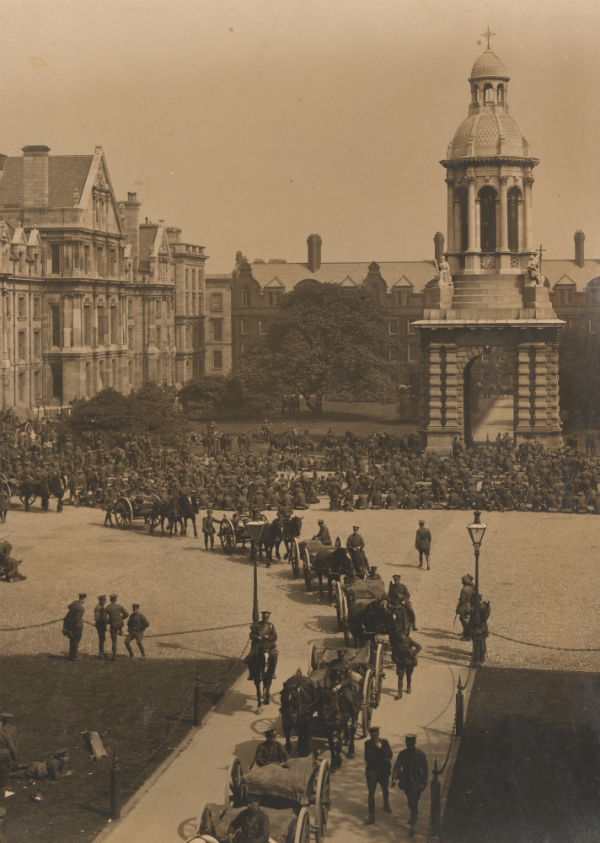100 years ago, Dublin was rocked by the outbreak of the Easter Rising. Trinity unavoidably played a central role in this due to its strategic city centre location. Because of its unionist tradition, Trinity stayed loyal to the British government.
Trinity goes into lockdown
On the outbreak of the Rising the gates were padlocked and sealed by the Head Porter who distributed pikes, captured from Fenians in 1867, to the other porters. Despite its location between several rebel garrisons the rebels never tried to take Trinity. It is not entirely known why but it is most likely they thought it would be too well defended by the Dublin University Officer Training Corps (OTC), who offered specialised military training to Trinity students. However, in reality Trinity was very poorly defended on Easter Monday. Most of the students were away from the College leaving only just 39 OTC men and 30 other soldiers on leave in Dublin who joined them defending Trinity’s 37 acres. The Trinity garrison, made up of the OTC, South African and Australian and New Zealand Army Corps (ANZAC) soldiers played a very important role in helping to quash the Rising. By positioning themselves on the roofs as snipers, they were able to disrupt communications between rebel headquarters at the GPO and the garrisons at City Hall, the Royal College of Surgeons and Jacob’s factory. This led to the death of one of the rebel dispatch riders who was coming down across College Green.
The British and Trinity
Two British soldiers were also killed in Trinity. All three were buried on the grounds of the College until the fighting was over. One of them Private Arthur Smith of the 4th Hussars is still commemorated by a monument on the Nassau Street wall, by the cricket pitch. By Tuesday 25th with the arrival of British troops Trinity became one of the main British garrisons in the city with an entire battalion stationed here (that’s 4000 men) as well as cavalry and artillery. Trinity’s strategic location also meant that it was used to shell the rebels on O’Connell St. In gratitude for the role of the OTC in suppressing the Rising they were presented with two cups by the businessmen of Grafton Street in thanks for protecting their businesses from destruction and looting. Another cup was also presented by Edward Carson the unionist leader to the OTC.
The role of students and alumni
There were also several Trinity graduates killed fighting with British forces during the Rising such as Frank Browning, who was killed at Boland’s Mill. Despite their role in ending the Rising many Trinity students were saddened at having to fight their fellow Irishmen. The view of the time Supreme Court judge, author and Auditor of The Hist, T. C. Kingsmill Moore summed up the mood of the time. In an editorial in college newspaper, T.C.D.: a college miscellany he said “Trinity College true to her traditions has played a worthy if unacceptable part. To be called upon to defend our University against the attack of Irishmen, to be forced in self-defence to shoot your own countrymen- these are the things which even the knowledge of duty well fulfilled cannot render anything but sad and distasteful”.
Less well known are the nationalist connections to Trinity in 1916. Several of the signatories and other leaders of 1916 had connections to the Trinity. Both Pearse and De Valera were briefly students at Trinity and Joseph Plunkett was the son of a Trinity graduate. Thomas MacDonagh had even applied for the chair of English, that is a professorship at Trinity in 1913. Indeed Pearse had been invited to speak at the inaugural meeting of the Dublin University Gaelic Society in November 1914. The meeting was banned on the grounds of Trinity by the Provost Mahaffy who said that he could not allow “a speaker with these to me traitorous views to address a meeting in the College” due to Pearse’s anti-recruitment activities. In the past Pearse had held parades and meetings to discourage people from joining the British army, disrupting recruitment drives and making anti-war propaganda. The students did not let this stop them and held the meeting outside the College. This led to the Provost disbanding the society in response. Trinity also produced a most unlikely rebel in the form of Harry Nicholls a Protestant Trinity graduate from Derry studying civil engineering. He was the only Trinity graduate to fight with the rebels in 1916. He acted as captain in the Irish Volunteers and fought with the Irish Citizens Army (ICA) at the St Stephen’s Green garrison led by Michael Malin. Nicholls despite his background was a very committed Gaeilgeoir and republican who was sworn into the Irish Republican Brotherhood in 1913 and was also involved in the Howth Gun Running.
However, by far the most significant Trinity connection to the 1916 Rising actually dates back over to over one hundred years before that through the Irish Revolutionary and Trinity student Robert Emmet. Emmet and his rebellion of 1803 was one of the major influences on Padraig Pearse who largely modelled the Rising off Emmets one. The 1916 Proclamation was actually heavily influenced by Emmet’s proclamation of 1803. Furthermore one of the inspirations for the idea of blood sacrifice came from the view that Emmet’s rising had been successful even though it had failed due to as Pearse said the “memory of a sacrifice Christ like in its perfection”.







